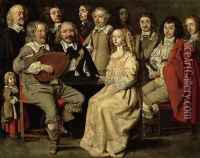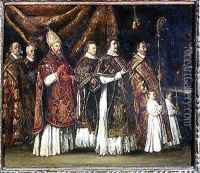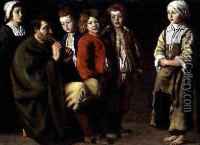Antoine Le Nain Paintings
Antoine Le Nain was a French painter born around 1588 in or near the town of Laon, in northern France. He is one of the three famous Le Nain brothers, alongside his siblings Louis and Mathieu, who were all celebrated painters of the 17th century. The brothers worked closely together, and because of this collaboration, it is often difficult to distinguish their individual contributions to their collective body of work. They are known primarily for their genre scenes, which depict everyday life with a sense of dignity and humanity.
The Le Nain brothers moved to Paris, where they shared a studio and developed a style that was distinct from the prevailing Baroque trend of the time. Their paintings often portray peasants and lower-class subjects with a remarkable depth of emotion and realism, which was not common during an era that favored more grandiose and idealized representations. Their work shows an acute observation of detail and a subdued color palette, emphasizing the humanity of their subjects rather than heroic or mythological themes.
Antoine, the eldest of the trio, is credited with influencing the direction of the brothers' artistic style. He is speculated to have been trained as a goldsmith before turning to painting. The Le Nain brothers were jointly admitted to the Parisian painters' guild in 1629, and they received the patronage of notable figures, including the bishop of Laon and the French monarchy.
Notable works attributed to the Le Nain brothers include 'Peasant Family in an Interior,' 'The Happy Family,' and 'The Forge of Vulcan.' These works are characterized by their intimate scale and compassionate representation of ordinary people. The brothers' paintings are considered important for their contributions to the genre of naturalistic and realistic representation in French art.
Antoine Le Nain's death in 1648 was followed by that of his brother Louis in the same year, and Mathieu outlived them both by only a few years. The true extent of Antoine's individual contributions remains unclear, but the legacy of the Le Nain brothers as a collective force in French painting is well established. Their works can be found in various museums and art collections around the world, including the Louvre in Paris and the Metropolitan Museum of Art in New York.



